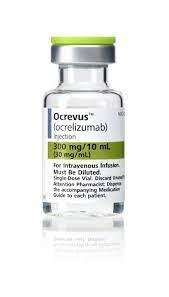Ocrelizumab Dosage
Medically reviewed by Drugs.com. Last updated on Nov 4, 2024.
Applies to the following strengths: 300 mg/10 mL
Usual Adult Dose for:
Additional dosage information:
Usual Adult Dose for Multiple Sclerosis
Initial dose: 300 mg IV followed 2 weeks later by a second 300 mg IV infusion
Maintenance dose: 600 mg IV every 6 months
RECOMMENDED INFUSION RATES:
INFUSION 1: (300 mg of this drug in 250 mL 0.9% sodium chloride injection): Start at 30 mL/hr and increase by 30 mL/hr every 30 minutes to a maximum of 180 mL/hr; duration of 2.5 hours or longer
INFUSION 2 (TWO WEEKS LATER): (300 mg of this drug in 250 mL 0.9% sodium chloride injection): Start at 30 mL/hr and increase by 30 mL/hr every 30 minutes to a maximum of 180 mL/hr; duration of 2.5 hours or longer
SUBSEQUENT INFUSIONS:
- OPTION 1 (600 mg of this drug in 500 mL 0.9% sodium chloride injection): Start at 40 mL/hr and increase by 40 mL/hr every 30 minutes to a maximum of 200 mL/hr; duration of 3.5 hours or longer
- OPTION 2 if no prior serious infusion reaction (600 mg of this drug in 500 mL 0.9% sodium chloride injection): Start at 100 mL/hr for the first 15 minutes and increase to 200 mL/hr for the next 15 minutes; increase to 250 mL/hr for the next 30 minutes; increase to 300 mL/hr for the remaining 60 minutes; duration of 2 hours or longer
Uses:
- For relapsing forms of multiple sclerosis (MS), including clinically isolated syndrome, relapsing-remitting disease, and active secondary progressive disease
- Primary progressive MS
Renal Dose Adjustments
Data not available
Liver Dose Adjustments
Data not available
Dose Adjustments
Dose Modifications:
- Mild to moderate infusion reactions: Reduce the infusion rate to half the rate at the onset of the infusion reaction and maintain the reduced rate for at least 30 minutes; if this rate is tolerated, increase the rate as normal (this change in rate will increase the total duration of the infusion but not the total dose).
- Severe infusion reactions: Interrupt the infusion and administer supportive treatment; restart the infusion after all symptoms have resolved; when restarting, begin at half of the infusion rate at the time of onset of the infusion reaction; if this rate is tolerated, increase the rate as normal (this change in rate will increase the total duration of the infusion but not the total dose).
- Life-threatening infusion reactions: Stop the infusion and permanently discontinue therapy; administer supportive treatment.
Precautions
CONTRAINDICATIONS:
- Active HBV infection
- History of life-threatening infusion reaction to this drug
Safety and efficacy have not been established in patients younger than 18 years.
Consult WARNINGS section for additional precautions.
Dialysis
Data not available
Other Comments
Administration advice:
- Prior to initiating therapy, perform Hepatitis B virus (HBV) screening. For patients who are negative for surface antigen (HBsAg) and positive for HB core antibody (HBcAb+) or are carriers of HBV (HBsAg+), consult liver disease experts before starting and during therapy.
- Prior to initiating therapy, test fir quantitative serum immunoglobulins; for patients with low serum immunoglobulins, consult immunology experts before initiating this drug.
- Premedicate patients with methylprednisolone (or equivalent) 100 mg IV approximately 30 minutes prior to each infusion and an antihistamine (e.g., diphenhydramine) 30 to 60 minutes prior to each infusion. The addition of an antipyretic (e.g., acetaminophen) may also be considered.
- In case of active infection, delay infusion until infection resolves.
- Visually inspect the solution for particulate matter and discoloration prior to administration; do not use the solution if discolored or if the solution contains discrete foreign particulate matter.
- Do not shake.
- If an infusion is missed, administer it as soon as possible; do not wait until the next scheduled dose. Reset the dose schedule to administer the next sequential dose 6 months after the missed dose is administered. Separate doses by at least 5 months.
- Observe the patient for at least 1 hour after infusion.
Reconstitution/preparation techniques:
- This drug should be prepared by a healthcare professional using aseptic technique.
IV compatibility:
- This drug can be mixed with 0.9% sodium chloride injection. Other diluents should not be used.
General:
- Prior to initiating therapy with this drug, the patient should be screened for hepatitis B (HPV). For patients who are negative for surface antigen [HBsAg] and positive for HB core antibody [HBcAb+] or are carriers of HBV [HBsAg+], consult liver disease experts before starting and during therapy.
- Because vaccination with live or live-attenuated vaccines is not recommended during therapy with this drug and after discontinuation until B-cell repletion, administer all necessary immunizations according to immunization guidelines at least 6 weeks prior to initiation of therapy.
- Prior to every infusion of this drug, determine whether there is an active infection; in case of active infection, delay the infusion of until the infection is resolved.
Frequently asked questions
- How much does Ocrevus cost?
- How long does it take Ocrevus to work?
- How long does an Ocrevus infusion take?
- Is Ocrevus a form of chemotherapy?
- How does Ocrevus work for MS?
- What are the new drugs used for multiple sclerosis (MS)?
- Ocrevus vs Aubagio: How do they compare for MS?
More about ocrelizumab
- Check interactions
- Compare alternatives
- Reviews (192)
- Side effects
- During pregnancy
- Drug class: CD20 monoclonal antibodies
- Breastfeeding
- En español
Patient resources
Other brands
Professional resources
Other brands
Related treatment guides
Further information
Always consult your healthcare provider to ensure the information displayed on this page applies to your personal circumstances.


